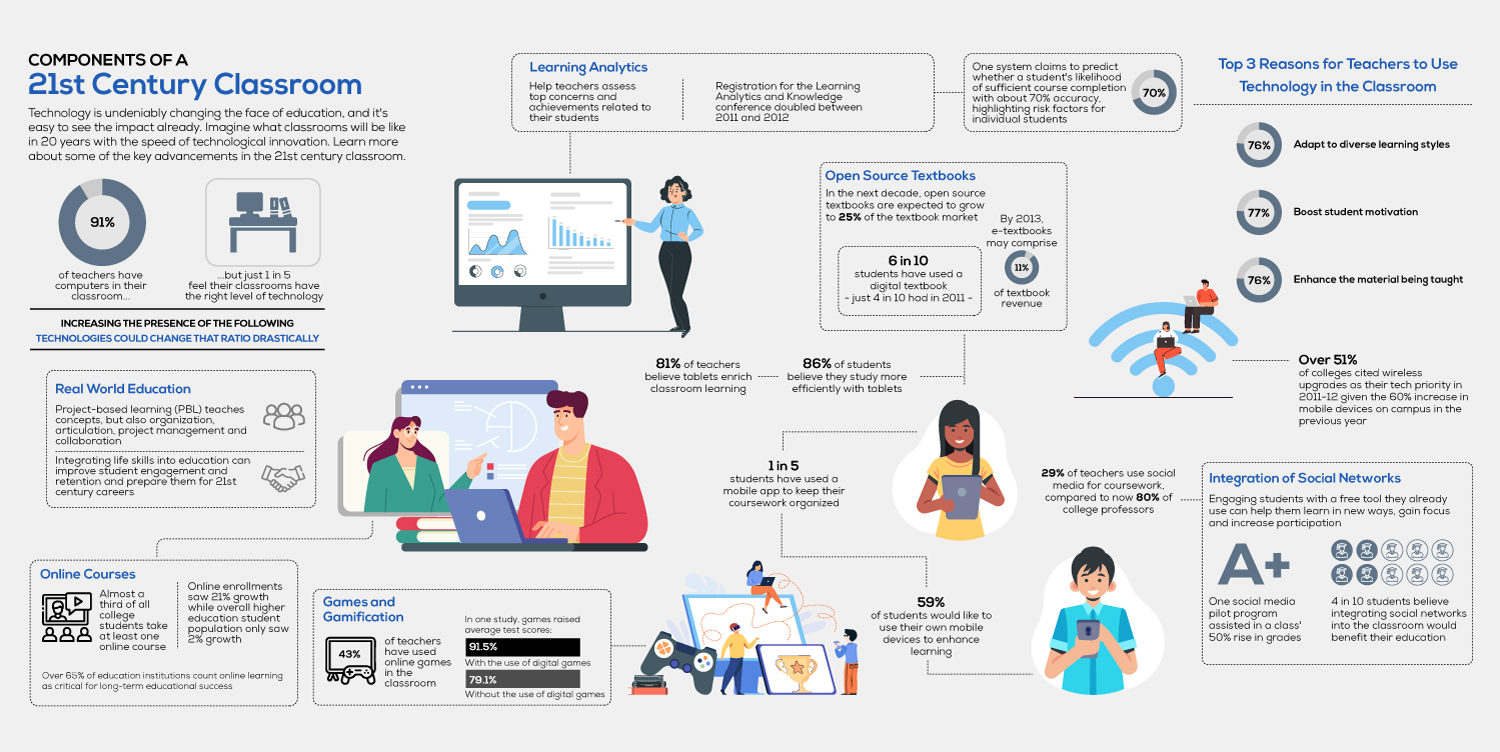Beyond Chalk and Talk: EdTech In Classroom Management
Classroom management, a very vital component of effective teaching, remains an understated facet in educational excellence discussions. This blog emphasizes the significance of adept classroom management, elucidating how it fosters a conducive learning environment. Furthermore, it explores technology’s untapped potential in ameliorating classroom management practices, thereby enabling teachers to optimize their instructional time and focus on innovative pedagogical approaches.
Classroom management serves as the cornerstone for a thriving learning environment. Despite its foundational importance, discussions on curriculum design, assessment strategies, and instructional methodologies often overshadow the vital role adept classroom management plays. This comprehensive exploration aims to shed light on the intrinsic value of classroom management, particularly for novice educators, and advocates for integrating technology to enhance its efficacy.
Classroom management is a complex concept that extends beyond the traditional understanding of the discipline. It encompasses establishing clear expectations, fostering positive teacher-student relationships, implementing consistent disciplinary measures, and creating an inclusive and engaging learning environment. Novice educators, in particular, may grapple with the complexities of managing diverse classrooms, making it imperative to address this aspect early in their teaching careers.
Effective classroom management forms the foundation for building a flourishing educational experience. Despite its centrality, discussions often overshadow it. Classroom management is more than focusing on curriculum design, assessment strategies, and instructional methodologies. The oversight of classroom management can impede the realization of pedagogical objectives and hinder student engagement. This blog highlights the integral role of efficient classroom management, particularly for novice educators, and proposes incorporating technology to enhance its efficacy.
The Overlooked Significance Of Classroom Management:
Extensive research consistently underscores the critical role of effective classroom management in achieving pedagogical objectives and augmenting student achievement. Meta-analysis highlights the correlation between positive classroom management practices and student achievement, emphasizing the need for educators to proactively address behavioural sciences, establish clear routines, and cultivate positive teacher-student relationships and also the need for educators to proactively work on behaviour, establish clear routines, and develop positive teacher-student relationships to create an optimal learning environment. Educational discussions often sideline classroom management, focusing more on curriculum development and assessment strategies. This oversight can compromise teaching effectiveness and hinder student engagement.
The focus on curriculum development, assessment strategies, and academic policies often takes precedence, leaving classroom management relegated to the periphery. This oversight can have far-reaching implications, as inadequate attention to classroom management may compromise teaching effectiveness and hinder student engagement.
The Role Of Technology In Classroom Management:
Advancements in educational technology offer transformative solutions to traditional challenges in classroom management. Classroom Management Systems (CMS), Learning Management Systems (LMS), student response systems, and digital communication tools allow educators to streamline administrative tasks, automate routine processes, and maintain effective communication with students and parents. By leveraging these technologies, teachers can efficiently manage assignments, track student progress, and provide timely feedback, enhancing classroom management.
Technology will be critical in shaping how classrooms function in the 21st century.

Classroom Management Systems
Classroom Management Systems (CMS) technology stands out as a transformative force, offering educators innovative tools to streamline administrative tasks, enhance communication, and foster a conducive learning environment. CMS has the potential to revolutionize the educational experience for educators and students.
Classroom Management Systems (CMS) technology is a comprehensive suite of digital features designed to assist educators in organizing, managing, and optimizing various aspects of classroom activities. Unlike traditional methods, CMS technology integrates seamlessly into the educational environment, providing a centralized platform for educators to handle administrative tasks, monitor student progress, and facilitate communication.
Learning Management Systems (LMS):
LMS platforms serve as centralized hubs for educators to organize and manage various aspects of their courses. These platforms simplify the learning curve for novice educators, offering intuitive interfaces to efficiently manage course content, track student performance, and facilitate communication within the virtual space.
Student Response Systems:
Also known as clickers or polling tools, these systems enable real-time interaction and engagement, allowing students to respond to questions, quizzes, or surveys instantly. Student response systems provide educators with immediate feedback, facilitating dynamic adjustments to teaching strategies and promoting an adaptive learning environment.
Why Educational Technology Or Edtech And Classroom Management Systems (CMS)?
Time-Efficiency And Innovative Pedagogy:
Integrating technology into classroom management liberates valuable instructional time by automating routine administrative tasks. This newfound time allows educators to focus on refining teaching methodologies, exploring innovative pedagogical approaches, and personalizing student learning experiences. Automation of administrative tasks, such as grading assignments and tracking attendance, enables teachers to provide meaningful insights rather than spending hours on manual tasks.
Personalized Learning:
With reduced administrative burdens, educators can dedicate more time to understanding the individual needs of their students. Technology facilitates the implementation of personalized learning experiences, tailoring instruction to students’ unique learning styles, abilities, and interests, and enables students to own their learning journey. Adaptive learning platforms adjust content and pace based on individual student performance, fostering a more student-centric approach to education.
Facilitating Innovative Pedagogy:
Technology catalyzes innovative pedagogical approaches, with virtual reality (VR), augmented reality (AR), and gamification enhancing the learning experience. Integrating these tools creates immersive and interactive learning environments, promoting deeper engagement and comprehension. Technology also enables collaborative learning experiences, transcending traditional classroom boundaries and encouraging active student participation.
In the radically evolving landscape of the 21st century, where artificial intelligence is reshaping the technological paradigm, integrating Educational Technology (EdTech) and Classroom Management Systems has become crucial for the modern educational ecosystem. This dynamic synergy between education and technology not only addresses the challenges posed by AI but also harnesses its potential to enhance the learning experience.
One of the paramount benefits of EdTech lies in its ability to revolutionize time efficiency and foster innovative pedagogy. By automating routine administrative tasks within Classroom Management Systems, educators can reclaim precious instructional time previously consumed by manual chores.
Automating tasks such as grading assignments and tracking attendance liberates educators from mundane activities, enabling them to redirect their efforts towards providing meaningful insights. As a result, teachers can engage in more personalized interactions with students, offering targeted support and feedback. It cultivates a more nurturing learning environment and empowers students to thrive in a tech-driven world.
Critical Components Of CMS Technology:
Digital Communication Tools:
CMS technology integrates various communication tools, sharing data via messaging and emails, to enhance communication between educators, students, and parents. Timely communication regarding assignments, deadlines, and essential information fosters transparency, contributing to effective classroom management.
Automated Administrative Tasks:
CMS technology automates routine administrative tasks, including lesson planning, grading assignments, tracking attendance, and managing resources.
Automation liberates valuable instructional time, allowing educators to focus on refining teaching methodologies and exploring innovative pedagogical approaches.
Recommendations And Conclusion:
In light of these insights, effective classroom management is indispensable for creating a conducive learning environment. Novice educators, in particular, benefit significantly from a nuanced understanding of classroom management principles and practices. Technology integration is a transformative solution, empowering educators to streamline administrative tasks, optimize instructional time, and delve into innovative pedagogical approaches.

Teacher Training And Professional Development:
To capitalize on the potential of technology in classroom management, educational institutions must prioritize comprehensive teacher training and professional development programs. Novice educators should acquire the skills and knowledge to navigate digital tools effectively, and ongoing professional development ensures educators stay abreast of emerging technologies and continuously refine classroom management strategies.
Policy Considerations
Policymakers play a crucial role in shaping the educational landscape, and they should allocate resources and support initiatives that promote technology integration in classroom management. Policies should recognize technology’s critical role in optimizing educational processes, ensuring equitable access to technology, minimizing the digital divide and ensuring all students benefit from these advancements.
Cultivating A Culture Of Innovation:
Educational institutions should foster a culture of innovation that encourages educators to explore and implement technology-driven solutions. Creating platforms for collaboration and sharing best practices facilitates the exchange of ideas, allowing educators to learn from one another and elevate the standard of classroom management practices.
Conclusion:
In conclusion, as technology providers, we underscore the intrinsic value of classroom management in educational settings and advocate for its elevation within the pedagogical discourse. By harnessing the capabilities of technology, educators can transcend the limitations of traditional classroom management, unlocking the potential for enriched learning experiences and fostering a new era of educational excellence.
By unlocking time and fostering innovative teaching practices, these technologies equip educators with the tools needed to navigate the challenges of the 21st century and prepare students for a future where technology and education intersect seamlessly. Recognizing the symbiotic relationship between effective classroom management, technology integration, and innovative pedagogy is crucial for realizing a transformative and future-oriented educational landscape.
